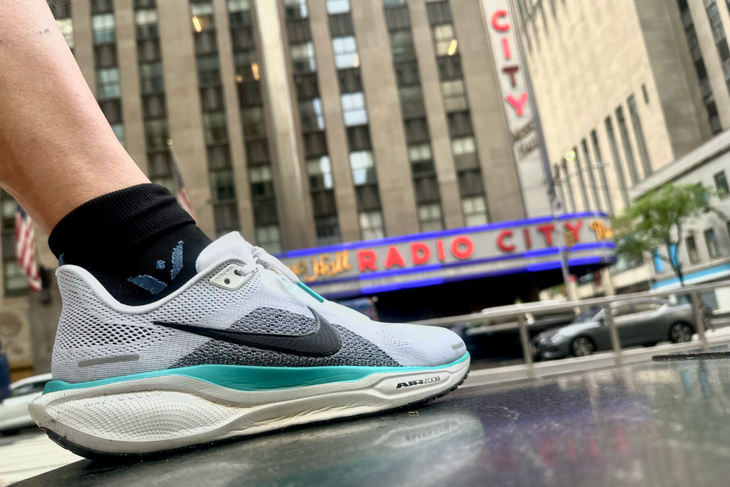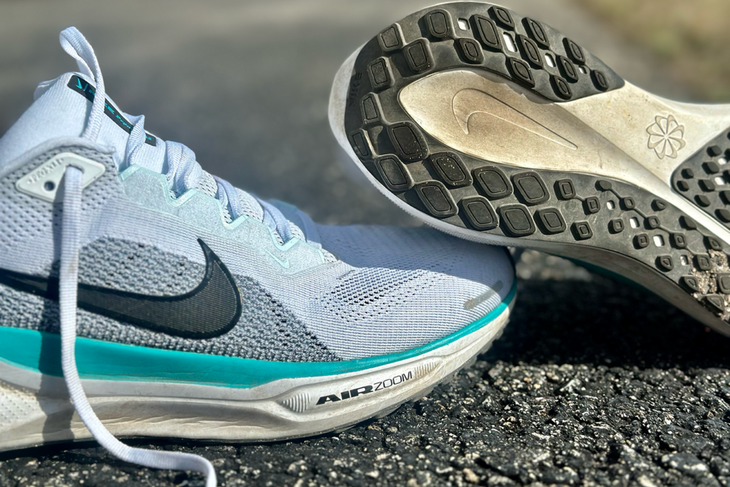New perk: Easily find new routes and hidden gems, upcoming running events, and more near you. Your weekly Local Running Newsletter has everything you need to lace up! Subscribe today.
I’d be dating myself if I told you about my first experiences running in Nike Pegasus training shoes, way back in high school—more than a decade before the turn of the century. But I’m fine with that, because, like the long history of the Pegaus, it makes me appreciate my longevity as a runner. Suffice it to say I’ve run in most of the 40 models that have helped build the Pegasus a historic legacy as one of the best-selling shoes in history.
Although my running has morphed considerably through the years—from a youthful trackster to a modestly fast marathoner, to an ultra-distance trail runner and now heading back down that distance curve as a masters runner who continues to think like a youthful trackster—I’ve enjoyed the Pegasus at every stage. The most prominent characteristic I have appreciated about the Pegasus through the years is its do-almost-everything versatility.
Since its inception in 1983, the “Peg” has gone through its own similar evolutionary journey, often oscillating between plush and performance. Although Nike has sometimes seemed to neglect it and veered off course with several of those models—including last year’s unremarkable 40th anniversary version—it’s generally been one of the brand’s flagship trainers delivering a combination of comfort and pep ideal for putting in daily miles at a variety of paces. By continually (eventually) being updated with better materials, the Pegasus has remained a workhorse trainer that has logged copious amounts of miles for new runners and experienced marathoners alike. My experiences, however, have varied greatly based on where specific models have ranked on the plush vs performance spectrum.
With that as a backdrop, I was eager to wear-test the Nike Pegasus 41 and reivew. So eager, in fact, I had to talk my friends at Runners Roost in Boulder, Colorado, into letting me take a pair out of their stock before the shoes were available for sale this week.
Specs
Price: $140
Weights: 8.8 oz. (women’s 8), 10.4 oz. (men’s 9)
Stack Heights: 37mm (heel), 27mm (forefoot)
Heel-to-toe Drop: 10mm
When you buy through our links, we may earn an affiliate commission. This supports our mission to get more people active and outside. Learn more.
At a Glance
Pros and Cons:
- A versatile and durable everyday trainer that veers more toward plush than performance
- Softly padded tongue, heel collar and sockliner round out a comfortable fit
- More sustainable materials and lower carbon footprint
- Cushioning package is mildly responsive with moderate energy return.
- Thick heel creates a penchant for heel-striking and a rolling stride
- Forefoot cushioning feels flat, limiting toe-off energy
What’s New:
- Updated cushioning package consists of a full-length layer of new ReactX foam with Air Zoom units embedded in the forefoot and heel for more responsiveness
- 4mm higher stack height (37mm/27mm) than Pegasus 40 (33mm/23mm) provides a bit more loft with the same heel-toe drop
- The revised engineered mesh upper is more breathable (and comfortable for me) than the past several models.
- The dynamic new lacing system is integrated into an internal midfoot band that wraps around the entire foot to provide a more comprehensive fit

Nike Pegasus 41 Review: First Impressions
When I first laced up the new Nike Pegasus 41, I appreciated the cushy step-in feel and was inspired to immerse myself in wear-testing it. In the span of a week, I ran in it every day (twice a day on two occasions), which included several easy- to moderately-paced runs in Boulder and Denver, an 11.8-mile jaunt around the Mineral Belt Trail in Leadville, Colorado, and an up-tempo fartlek loop through Central Park in New York City. I didn’t do any specific speed workouts, but I did throw in some strides after most of my runs.
First and foremost, I noticed the cushioning in the heel, which is both softer and noticeably higher off the ground than any Pegasus I’ve worn in the past. Nike replaced the original React midsole foam with a layer of its new ReactX foam (which it says produces 13 percent more energy return) and retained the Air Zoom units embedded in the forefoot and heel. I definitely sensed the improved responsiveness from the previous versions of the Pegasus, but the distribution of the cushioning seemed to make it primarily conducive for a heel-striking stride. That felt just fine running at slow to moderate paces, but when I ramped up to quicker paces I didn’t feel much energy return through the forefoot and felt like I had to do a lot more work to run fast—especially when running strides. (I actually didn’t sense any added cushiness or boost from the Air Zoom units in the heel or the forefoot—which seem to be tuned significantly softer than those found in Nike’s performance shoes.)
Obviously, the modern world of running shoes—which is dominated by max-cushioned, hyper-responsive training and racing shoes—has skewed my expectations quite a bit, and I have to admit, that often leaves me craving for more from shoes with a more traditional midsole feel. I was initially seeking more bounciness or at least the rolling action of a rocker shape as I was running in this version of the Pegasus—especially in the forefoot.
However, as I ran more miles I came to appreciate it for what it is—a nicely executed update to many of the most recent iterations of the Pegasus. To me it’s a good entry-level shoe that’s comfortable, durable and versatile—but also limited. It doesn’t produce an exceptionally lively ride and doesn’t have enough cushion from heel to toe for me to want to choose it for a long run. At best, it’s a fun, comfortable shoe for a new runner to immerse more into running, but at worst it’s an average shoe for middling midweek mileage. True to its history, the Pegasus has wavered between plush and performance, and this one is definitely more about an opulent fit, feel and ride than it is about energy return or sustained up-tempo running ability.

Nike Pegasus 41: Who Is It For?
Like most of its predecessors since 1983, the Nike Pegasus 41 is a versatile everyday training shoe with a nice mix of cushioning, comfort, and durability. It’s a great choice for new, novice and casual runners who are seeking a model that can do most things well at an affordable price. It can also be a secondary shoe in the quiver of more advanced runners who might be seeking a different underfoot sensation a few times a week to get away from running in maximally cushioned shoes all of the time.
Similar Shoes
Saucony Ride 17, Hoka Clifton 9, Adidas Supernova Rise, Asics Cumulus 25, Brooks Launch 10, New Balance Fresh Foam 880 v14, On CloudGo
